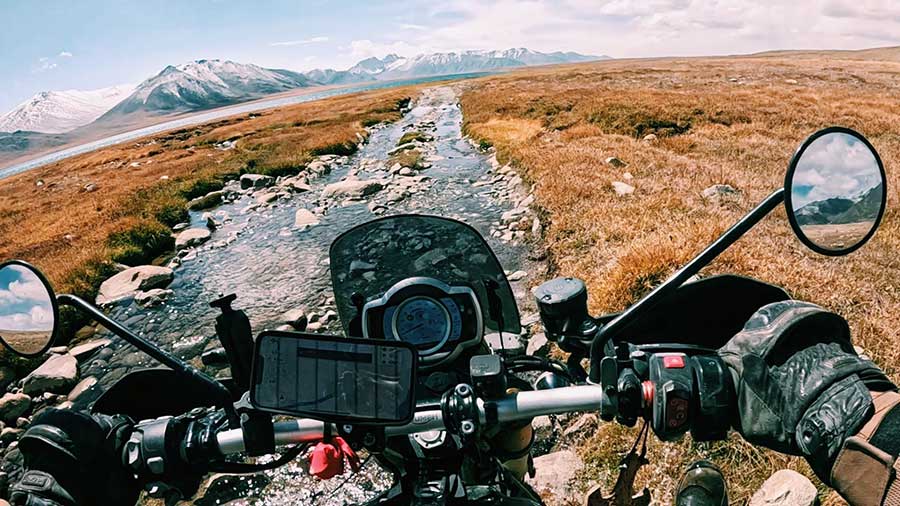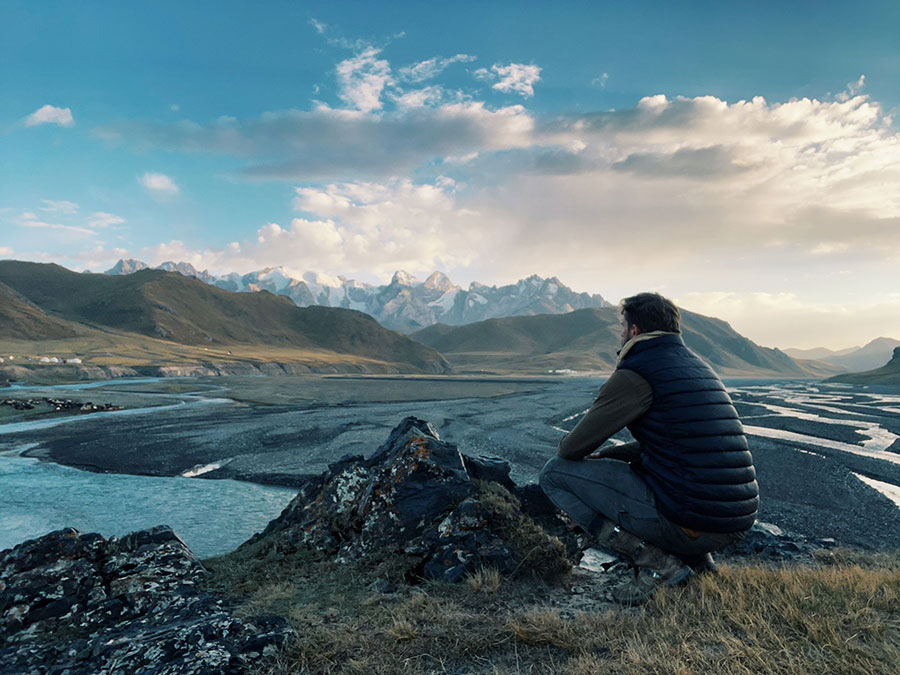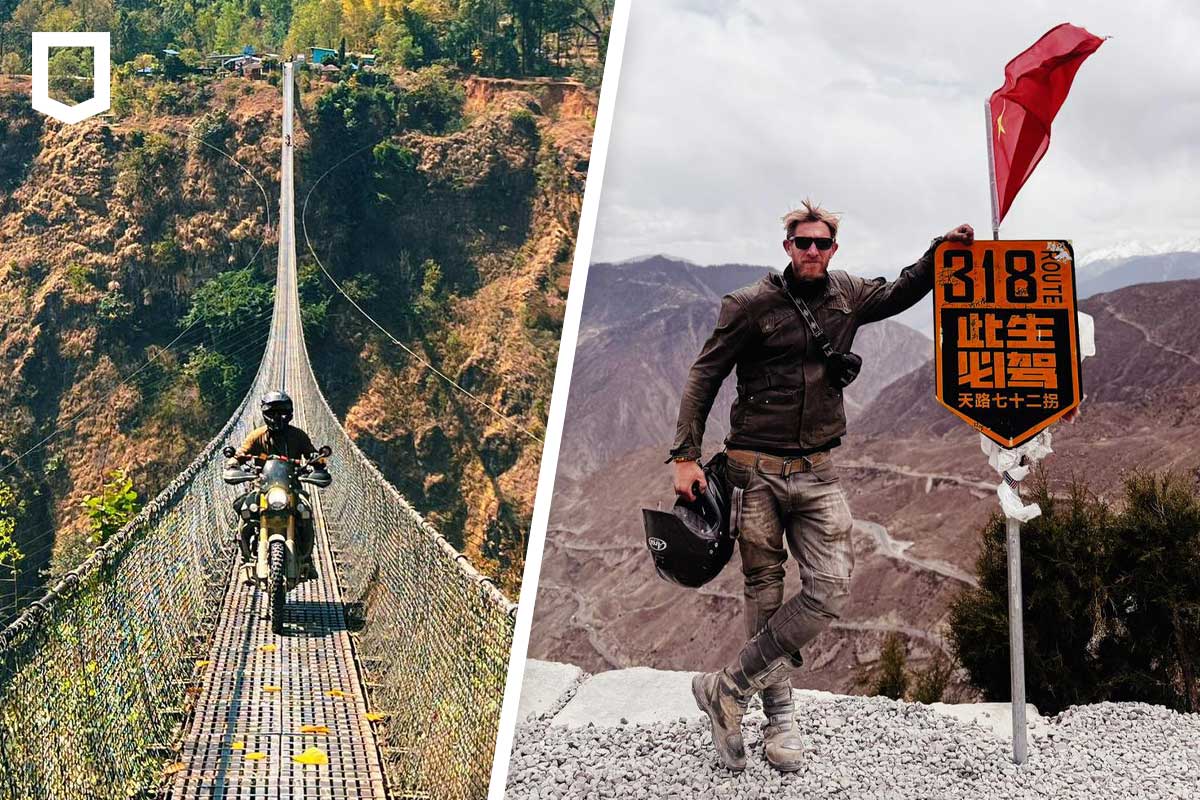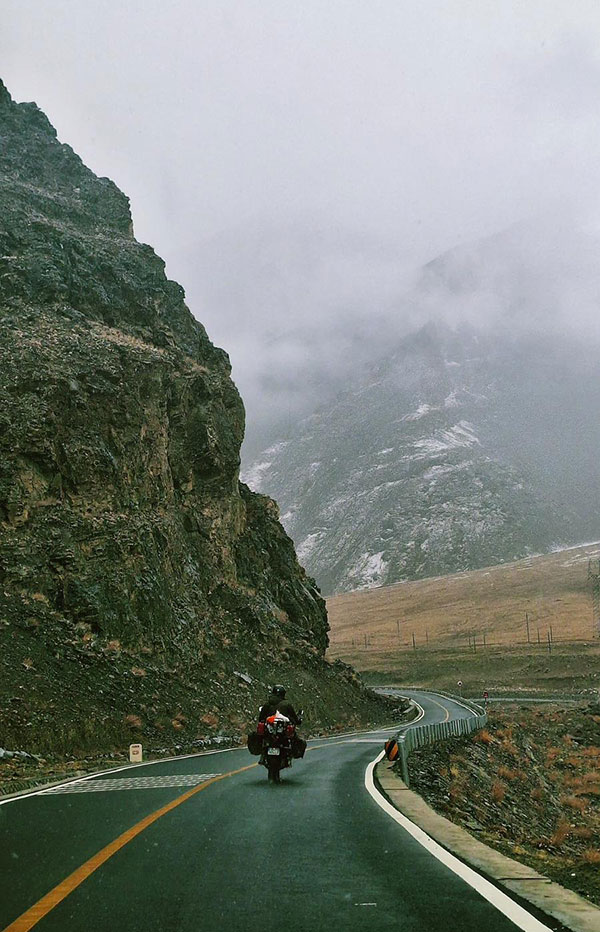What does it take to ride solo across the world? For Max, aka The Scrambling Nomad, it took guts, grit, and a Triumph Scrambler named Tara. Since leaving the UK, he’s crossed deserts, scaled Himalayan passes, and rolled through Taliban checkpoints. But this journey isn’t just about distance, it’s about facing demons, finding purpose, and pushing limits. In this exclusive interview, Max shares what it means to travel without a safety net and why some roads are meant to break you before they set you free.
1) You’ve travelled through intense environments, from the Pamir Highway to Taliban checkpoints. How do you manage fear and uncertainty?
Fear’s a constant companion. I’m not going to feed you platitudes about “trusting the universe” or surrendering to fate. Sometimes fear is the thing that keeps you alive. It sharpens you. Gets you out of tight spots.
The trick is to feel it, but not be ruled by it.
I’ve had terrifying moments on this trip. Accidents, armed robberies, dodgy borders, mechanical failures in the middle of nowhere. But honestly, the two scariest moments have been: 1) deciding to go, and 2) wondering what the hell comes next when it’s over.
Those are the fears that grip deeper. The existential ones. The ones that mess with your identity.
Everything else, the mountains, the deserts, the gunmen, you figure out. You navigate. You ride through. It’s the internal terrain that’s trickier. The fear that maybe you’ll never belong anywhere again. Or that this wild ride is the only thing holding you together.
 2) What inspired you to leave everything behind and ride around the world on two wheels?
2) What inspired you to leave everything behind and ride around the world on two wheels?
In 2021, I was diagnosed with Major Depression and Complex PTSD. After 14 years of service, the military medically discharged me. I was in a dark place, throwing myself into therapy, trying to heal before my last day in uniform, before I officially became a civilian. The pressure I put on myself nearly broke me.
My therapist suggested I take some time for myself, do something I actually wanted to do. I remembered that when I rode my motorcycle, the noise in my head would soften. So I headed to Morocco for three weeks, alone on my bike. I almost didn’t come back. But on the return trip, crossing the Spanish Pyrenees, I had a kind of eureka moment: I’m going to ride around the world.
That idea gave me purpose. A goal. A mission. From that point on, everything in me went into planning the trip. Some people might call it extreme, but honestly, I had nothing left to lose. Deep down, I wanted to prove to myself that even if the military no longer considered me “fit,” I could still go out there and do something extraordinary. It was about proving I was still capable. Still alive. I had to listen to the call.
Or maybe it was just a massive midlife crisis. Hard to tell.
3) You’ve called Tara, your Triumph Scrambler, the Green Goddess. What makes her special, and why is this bike for such an ambitious journey?
Tara’s a Triumph Scrambler 1200 XE. Not the obvious choice for this kind of trip. Most seasoned overlanders would tell you to pick something lighter, more manoeuvrable, easier to pick up when it drops. And yeah, lifting 300 kg of dead weight in 40-degree desert heat is a serious energy sapper.
I almost sold her before the trip. Took pictures, started prepping the ad. But I took her out for one last ride and realised: I loved her too much. I couldn’t do it without her. We had to go together.
I named her Tara after the Tibetan Green Goddess of healing. There was symbolism in that. It felt right. When I finally rode her through Tibet and Nepal, surrounded by Buddhist iconography, I knew I’d made the right choice. She belonged there. So did I.
She’s a big bike. Heavy. A bit cranky at times. But she’s been loyal, through this journey and long before it. And I intend to stay loyal to her, all the way to the end of the world. Ushuaia or bust.

4) Rishikesh seemed to have a strong pull on you. What was it about that place that made you stay longer than planned?
Rishikesh cast a spell on me. I’m not sure if it was the clean Himalayan air, the softness of the people after the intensity of Afghanistan and Pakistan, or just the fact that my nervous system finally had space to breathe. You have to picture it to understand how soothing and calming that place is, a small haven of peace nestled at the Himalayan foothills, nicknamed the yoga capital of the world. It draws people from all over searching for stillness and healing.
The Ganges runs through the centre of it, banks lined with colourful ashrams, rocks painted with Sanskrit script. There’s a quiet reverence that settles in your bones.
When I first arrived, I was angry. Burnt out from Central Asia. But the river flowed past my ashram like a balm. Incense hung in the air. I got adopted by a scrappy little husky street dog I named Laloo. My room was simple, almost monastic, but it overlooked the water. Each night, priests would perform fire rituals on the riverbanks, chanting as the sun set behind the mountains. There was something profoundly grounding in that rhythm.
The snows had closed the high passes, I couldn’t leave even if I wanted to. So I stayed. And slowly, I let the stillness hold me.
Rishikesh didn’t heal me. But it gave me space. A pause. And in that moment, that was enough.
5) What’s one place you’ve visited so far that took your breath away, and one you’ll never forget for tougher reasons?
Afghanistan. Hands down.
I deployed there in 2014 as a soldier. Ten years later, I returned as a lone rider, unarmed, civilian, on a bike. The Panjshir Valley… snowcapped peaks, turquoise rivers, silence. It felt untouched. Otherworldly.
But it’s the people who stay with me most. Despite everything they’ve endured, they carry themselves with strength and fierce hospitality. When they offer you brotherhood, it means something. It means everything.
I planned to pass through in three days. I stayed three weeks. The Sultans of Kabul, an Afghan motorcycle club, adopted me. We rode together through the mountains, AKs strapped to our backs, drag racing through Taliban territory at night. It sounds insane. But I felt more alive, and more protected, than I had in years.
There’s a brutal honesty to Afghanistan that doesn’t leave you untouched.
In terms of raw natural beauty, Nepal is right up there. The Himalayas in the Khumbu region are unlike anything I’ve seen. Immense. Mythical. But again, it’s the people. The Sherpa communities, their resilience, their reverence for the mountains. Living at altitude, they survive through shared effort and connection. The mountains aren’t just rock, they’re sacred beings. You feel it. You carry it.

6) And finally, what does success look like to you now, compared to before you started this journey?
Honestly? I’m not even sure what success looks like anymore.
I’m 14 months in, somewhere in Southeast Asia. Most of the original plans have changed. so many times I started with a clear vision: complete the circumnavigation. Plant the flag. Finish the mission.
But right now, I’m tired. Travel fatigue has crept in. There’s a slow ache, physical, emotional. Tara’s wearing down. More breakdowns. More questions. Some days, I wonder if I’ll even finish.
Success now feels quieter. Less cinematic. It’s finishing well. Crossing that last border and being able to say: I did it. Maybe not perfectly. But honestly.
So I focus on small wins. One day at a time. Fix what’s broken. Keep rolling forward. Next up is the Pacific, shipping Tara, landing in the Americas. The last leg. I feel dread and excitement in equal measure.
In the end, I think success will be this: to return more whole than when I left. To integrate what I’ve seen, who I’ve become.
As Kipling wrote:
“If you can dream, and not make dreams your master,
If you can think, and not make thoughts your aim,
If you can meet with Triumph and Disaster
And treat those two impostors just the same…”
That’s the line I hold onto now.
Success isn’t the summit. It’s surviving the climb without losing your soul. Or perhaps… finding it?


 2) What inspired you to leave everything behind and ride around the world on two wheels?
2) What inspired you to leave everything behind and ride around the world on two wheels?